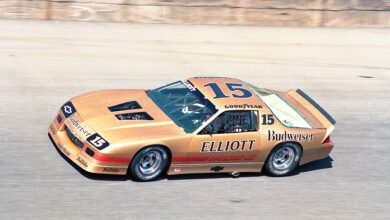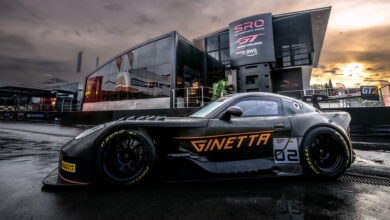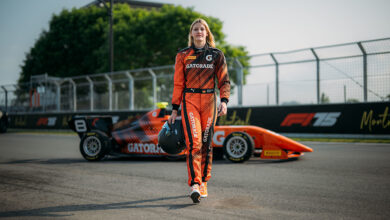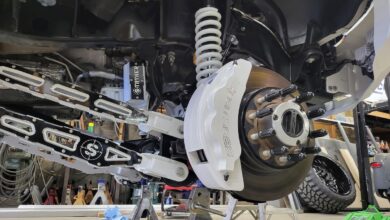International Drag Racing Hall of Fame Names 2019 Class
The Don Garlits Museum of Drag Racing, home of the International Drag Racing Hall of Fame, has announced the Class of 2019 honorees to the Hall of Fame. This select group includes a trio of top regional Top Fuel teams that contributed to the growth of the class in their time, a multi-talented racer/track operator/race team executive, and a manufacturer with a must-use product, which found a home in a variety of racing applications.
The museium also named recipients of the Founder’s Award and the Patricia Garlits Memorial Award.
The Don Garlits Museum of Drag Racing Class of 2019, with biographies from the museum, are:
The Carroll Brothers, “Texas Whips” William “Bones” and Curt Carroll
The Carroll Brothers hailed from Irving, Texas, and were major players in the Top Fuel class during the 1960s and into the early ’80s. The Carroll Brothers, Bones and Curt, owned Carroll Brothers Erection Co., which built steel buildings, but the two men had a deep passion for drag racing. They boasted some of the sport’s top racers of the time driving for them, including Gary Bailey, Kenny Bernstein, Buddy Cortines, Bob Gibson, Ben Griffin, Marshall Love, James Ludden, Murray Oxman, David Pace, Dave Settles and Richard Tharp.
The Texas Whips made a successful transition from the front-engine dragster era to the new rear-engine cars, with David Pace and Richard Tharp delivering some of the most memorable results. Tharp recorded the first sub-6 second run at NHRA Springnationals in Englishtown, New Jersey at 5.97 seconds in 1975; and Pace recorded two runners-up finishes at Denver’s NHRA Mile High Nationals and at the prestigious NHRA U.S. Nationals in Indianapolis in 1981, and scored a ninth place points finish that year, despite running less than half of the events.
Over the years, the Carroll Brothers did most of their racing in and around NHRA’s Division 4 (South Central Division), winning a number of races and season championships along the way.
Gary Rupp and Pat Dakin
Rupp and Dakin raced as the “Rupp & Dakin” top fuel team and were strong competitors in the NHRA’s very tough Division 3 (Midwest Division). Rupp owned the car and served as crew chief, while Dakin handled the driving chores. The pair started racing in the Gas class in 1970, and moved to the Top Fuel class in 1971, racing a front-engine dragster for one year. Seeing the rear-engine dragsters become consistent winners, the pair switched to a Hemi-powered Woody Gilmore chassis the following year.
Rupp & Dakin cars were always sharp appearing, and performed as well as they looked. When matched against the national touring teams, the pair more than held their own. They raced heavily at divisional races because of their businesses, but would occasionally venture out to compete at select national events east of the Mississippi River.
Within the Midwest Division, the pair were always one of the teams to contend for a win. They won the NHRA’s Le Grandnational Molson national event at the Sanair Dragstrip outside of Montreal, Canada in 1971 and again in 1973. The pair bought a new chassis for the 1975 season, and ran it through the 1977 season when they retired from competition.
Then, in 1989, they returned to the sport, and immediately were contenders, winning the International Hot Rod Association’s (IHRA) Top Fuel title that year. The team disbanded in 1993, when Rupp retired and moved to Carlton, Florida. Today, Dakin continues to race competitively in selected NHRA events, while continuing in his professional life as the owner of Commercial Metal Fabricators in Dayton, Ohio.
Dan Richins & Rex Pearmain
Richins and Pearmain, known as the Iron Horse Team, were not household names in the world of drag racing. The fact is, Salt Lake City is a bit off the beaten path when it comes to significant drag racing teams. However, during the mid-1970s, the Iron Horse Team-with Richins as owner/driver and Pearmain as crew chief-were significant forces with which to be reckoned. This was particularly true at the high elevation dragstrips found in the NHRA’s Division 5 (West Central Division), Division 6 (Northwest Division) and Division 7 (Pacific Division).
Between 1971 and 1976, Richins and Pearmain aggravated a number of Top Fuel racers in divisional events because Pearmain had the knowledge of how to tune an engine to deliver reliable, repeatable performance in the thin air (low oxygen) of high altitudes.
The Iron Horse Team was a comparatively low budget operation, and chose to race cautiously, while at the same time being competitive. There were several low qualifier and track elapsed time records in their career.
When the Iron Horse Team went to low altitude tracks, Pearmain’s tune-up to compensate for the oxygen-rich conditions coupled with Richins’ driving skills, delivered some significant results. The team’s career-defining moment was the stunning 5.930 seconds elapsed time recorded at the NHRA’s Supernationals in Ontario, Canada in 1973, which secured them the No. 8 spot in the prestigious Cragar 5-Second Club (and the first Donovan hemi-powered car in the club), plus low qualifier positions at American Hot Rod Association’s (AHRA) Northern Nationals at Fremont, California.
Mike Lewis
Lewis could be described as a man for all seasons. He was almost born into the world of drag racing, when his grandfather, Alfred Stauffer, built the famed Maple Grove Raceway in Mohnton, Pennsylvania when Lewis was 12 years old. Racing got into his blood even earlier, when his father would take him to the famed Williams Grove dirt track to watch the midgets and USAC Champ cars battle. However, his loyalty changed when he first heard a nitromethane-fueled dragster’s crackling, thundering exhaust.
During his teen years, Lewis worked at the family’s dragstrip, learning just about every facet of the track from the ground up. After graduating from Kutztown University he returned to the track in a management role, including announcing. He also partnered with his brother Kent in the Sparkling Burgundy top fuel dragster, which the pair campaigned from 1970 to 1976. He stopped driving to become the Track Manager in 1971, and later assumed the role of president.
Lewis left in Maple Grove in 1989 to join NHRA as vice president of field operations, overseeing the NHRA’s seven divisions and member tracks. In 1995, he was named vice president of NHRA, and also general manager of the NHRA’s Indianapolis Raceway Park, home of the NHRA’s crown jewel event, the U.S. Nationals.
In 1998, drawing on his vast experience in track management and his relationships in the sport, Lewis formed Ace Ventures in Indianapolis, a motorsports consulting organization. He joined Don Schumacher Racing as vice president-a position he holds today-and helped develop the team’s position as a premier motorsports operation, featuring three top fuel cars and four fuel funny cars, which have won 16 world championships and over 200 events.
In 2007, Lewis rejoined his family’s race track operations, and currently serves as president of Maple Grove Raceway.
Lewis continues race in select Nostalgia drag racing events, winning the 2012 NHRA California Hot Rod Reunion Funny Car class in the Gutierrez & Smith Brand X Ford Mustang funny car. Over the course of the years, Lewis has created or collaborated in a number of special initiatives between the sport and several charities.
Ted Dzus, Jr.
Dzus, Jr., known affectionately as The Quarter Turn Man, took a product technically known as a cam-locking fastener, but commonly known as a Dzus Fastener (pronounced Zuce), from the aircraft industry and into the motorsports and custom automotive arenas. The Dzus Fastener was the brainchild of Dzus’ grandfather, William, an immigrant Ukrainian engineer who worked for a Long Island aircraft company in the 1930s.
Developed to secure aircraft body panels that previously were loosening and rattling, the fastener was simple, using a spring wire and a button shaft machined to accept the spring into an over-center locking fastener, which required only a quarter of a turn to lock or unlock. Following World War II, Army and Navy aircraft mechanics remembered this straightforward, strong, easy-to-use fastener, adapted it to the race car market. The first recorded use in motorsports was by the famed Justice Brothers (Ed and Zeke) in California on a Kurtis-Kraft midget oval track car. Frank Kurtis did not like the fact they went behind his back, but he quickly saw their value.
Working for his grandfather and father at the company in the 1960s, Dzus, Jr.’s love for automotive performance helped expand the company’s market horizons outside the aircraft industry. Ted Dzus, Sr. became president of Dzus Fasteners in 1964, after his father’s death, and Dzus, Jr., assumed control in 1982.
The idea spread to drag racers like Don Garlits and others, and the Dzus Fasteners were marketed by Mr. Gasket and Moroso. They became must-use items to quickly secure body panels, which were often removed to access the engine and driveline for service in almost all forms of motorsports.
The Don Garlits Museum of Drag Racing Class award winners for 2019, with biographies from the museum, are:
Edward Justice, Sr. – Founder’s Award
The late Justice, Sr. was one of three brothers who established themselves as early leaders in the automotive lubricant and fuel additives market in the early 1950s. The brothers-Ed, Zeke and Gus-were actively involved in business, even as teenagers in their hometown of Paoli, Kansas before World War II.
Ed served in the U.S. Army Air Force in England, and when he returned, he and Zeke went to work for Frank Kurtis at Kurtis-Kraft, building sprint cars and midgets for oval tracks. They moonlighted on evenings and weekends, with their own enterprise, Justice Brothers Race Car Repair and Fabrication. All the while, they experimented with lubricants and additives to increase performance and longevity.
Using proceeds from selling a midget racer they built, the brothers started Justice Brothers Inc. to market the line of lubricants and additives. Ed ran sales, Gus was the accountant, while Zeke developed and tested new products. Ed’s ability as a salesman and marketer propelled the company to success.
Ed knew the world of motorsports would be a wonderful marketing tool, and he aligned the company with the newly formed NASCAR, the Championship Car circuit and the Indianapolis 500, and the NHRA drag racing circuit. Quickly, race cars were carrying Justice Brothers decals, and Ed began to sign prominent drivers as company spokesmen.
In 1950, Johnnie Parsons won the Indianapolis 500 in a Justice Brothers-sponsored Kurtis-Kraft roadster, and the first of the Justice Brothers shirts appeared at the Southern 500 NASCAR race at Darlington, South Carolina. Soon after, an aspiring young drag racer named Don Garlits was signed by Ed, and the Justice Brothers was Garlits’ first corporate sponsor.
Today, under the guidance of Ed’s son Ed Justice, Jr., the company remains a force in automotive and industrial chemicals, headquartered in Duarte, California.
Lynn Prudhomme – Patricia Garlits Memorial Award
Don Garlits selected to recognize Lynn Prudhomme with the Patricia Garlits Memorial Award for 2019, in honor of his late wife, Pat, given annually to honor a woman involved with drag racing who has exhibited a selfless devotion to the growth and betterment of the sport.
Prudhomme is the wife of drag racing superstar, Don “The Snake” Prudhomme, and has been at the forefront of efforts to help racing families in need. She was one of the driving forces behind the formation of DRAW (Drag Racing Association of Women), which has been there to support families of drag racers who have been injured in racing accidents, helping to defray some expenses, since 1985.
Additionally, Prudhomme has been a core for the family, raising of daughter Donna, while supporting her husband as he crisscrossed the country during his 35-year racing career, as a driver, and later as a team owner.
“Like Pat,” Garlits commented, “Lynn has always been there for others, often putting their needs ahead of her own.”



